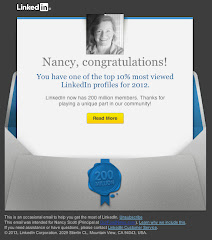I hesitate to climb aboard the 2010 Prediction Train, so let me just say that – amid much handwringing in the newspaper, magazine, and direct mail industries -- niche and local seem to be carving a spot. Meaning what?
An article two weeks ago in the Baltimore Sun reported that “Niche E-Newsletters are Healthy and Happy.” What the author, Gus G. Sentementes, was talking about are centrally-produced, but niche-slanted, electronic newsletters like those produced by SmartBrief. I first became familiar with SmartBrief six or seven years ago, when I noticed that the International Franchise Association was sending out a fabulous electronic newsletter every week. How were they doing such a professional job with no increase in staff? By signing on with a publisher that figured out how to mass-produce industry specific electronic newsletters, that's how! Today, Sentementes notes that SmartBrief has 100 employees, does 150 email newsletters, and has been profitable since 2002.
Into that smart mix, I now must toss publications like Local Kicks, a terrific e-newspaper that serves the Alexandria area in Virginia. Not only does this little newspaper have terrific journalism and an appealing “insider” writing style, it seems to enjoy its share of advertising, too.
Local goes beyond publishing, of course. Websites like LocalHarvest encourage people to buy food from local farmers, with great listings of “where and how.” But publishers also are doing well with the local angle. Researcher/consultant Greg Sterling reports that even Google is interested in local. Sterling also says, “..2010 is going to be all about leveraging social media in the local space.”
The best evidence may lie in the 2009 success of Groupon -- the “deal-of-the-day” website that is localized to major markets in the United States. In early December, Chicago-based Groupon got a $30 million financing infusion, and “the company is going gangbusters,” according to TechCrunch’s Michael Arrington.
There's no real surprise here: The Internet both decentralizes the outreach, and lowers distribution cost... which is why smart publishers will find more ways to capitalize on niche and local in 2010.
-- scrubbed by Marketing Brillo


